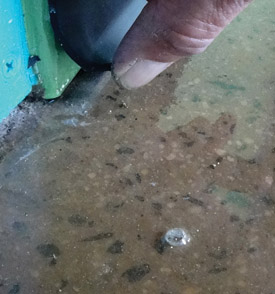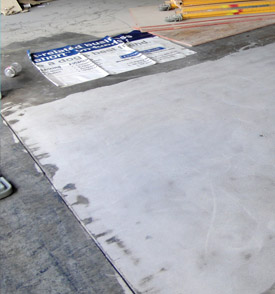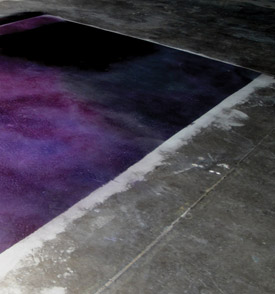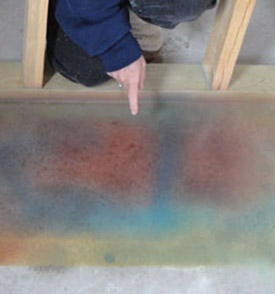
Four Factors for Flooring Success
Part 3: Flooring Installation
By Grant Loyd

Photo A: This is what happens when dogs get on new floors before they have cured enough to accept traffic. Waiting until the floor is ready to be used will avoid damage. In this case, the floor was put down correctly, so the damage was literally caused by a scheduling error.
Previously in the “Four Factors for Flooring Success” series, we looked at the proper selection of materials and floor preparation. Now we’ll look at considerations for applying the materials. What can you do to ensure your flooring is properly applied?
Certainly following the application instructions and precautions for flooring products and using good techniques and proper tools are important. When analyzing the causes of flooring failures, these types of application errors are commonly present, but the most important questions are often not addressed. The following questions need to be answered:
What causes application errors?
How can they be avoided?
From my experience, application errors are not really the “root” cause of floor failures. Yes, they are significant as a “direct” cause for failures, but why do those errors occur so often? Underlying issues are ultimately responsible for causing application errors that result in floor problems and failures. The issues are misunderstandings and false assumptions about the critical, unique nature of flooring installation on concrete. If you become aware of these inaccurate assumptions and how they set the stage for application errors, you can go a long way toward avoiding problems with your new flooring treatments.
1. People think applying flooring treatments, sealers, coatings, and decorative enhancements to concrete is like painting: open the can, spread the paint evenly with a sprayer, brush, or roller, and you’re done. It is really pretty simple, and almost everyone has done painting successfully. Put it on until it hides or covers, and you are good to go.
Unfortunately, applying products to concrete floors is incredibly more complicated than painting walls. Beyond how easy people think “painting” is, manufacturers’ directions add to this popular misconception. Many products are sold by advertising designed to make them sound easy to apply.

Photo B: The application errors of using a roller and applying too much sealer in hot conditions result in severe bubbling. Sealer should have been lightly sprayed on when the concrete was not hot. Multiple, lighter coats of sealer are almost always better than heavier coats.
While people are most inclined to equate flooring with painting, the assumptions about flooring also extend to other construction trades. Doing floors is not similar to electrical, plumbing, carpentry, sheet rock, or heating and air conditioning. Installation of flooring is exceedingly more variable than doing work in other trades. Due to the unique nature of flooring installation, you need to manage or oversee flooring issues differently than you do for activities done by other trades.
If you are a do-it-yourselfer, not understanding this difference and proceeding based on your experience with painting or other construction categories will lead to problems. If you hire someone to do the floors for you, then you need to understand that contractors also have underlying tendencies that contribute to flooring application errors, shortcuts, and failures.
2. Many contractors do not specialize in floors (e.g. general contractors), but they, like everyone else, are familiar with painting and generally think it is pretty easy and straight forward. They may not really know the critical details of flooring application.
Secondly, if contractors have experience applying flooring treatments, they tend to think they know what they are doing. Typically they are familiar with and trained in using certain products and assume the same techniques can be applied to all “similar” products. As a result, contractors may resist reading application instructions and precautions on data sheets. They tend to think if they have successfully put down sealers, epoxy, or other floor treatments, then they can do any similar product in the same way they have always done it. (In over 20 years of working with do-it-yourselfers and contractors, I have found that it is generally easier to get DIYers than contractors to read and follow directions for applying products they have not previously used.)
Keeping the first and second points in mind, consider the third dynamic that combines with them to create a situation leading to poor floor installations.

Photo C: Over-application caused bubbles in epoxy. When wet films are too thick, materials cannot cure or dry properly, resulting in surface defects.
3. The pressure that comes from rushing the completion of floor projects prevents DIYers and contractors from taking the time to find out what is properly required and doing it. Whether you are building a new facility, remodeling an existing area, or doing maintenance or rehab of an existing floor, scheduling adequate time for application is extremely important.
If the job is a rehab or maintenance of an existing floor, it will ordinarily be done when your facility is operating. Because down time means money lost, there is always pressure to rush the job to get the fastest return to service possible.
In the case of construction situations, with both remodels and new construction, things don’t usually go according to schedule. Most people find that their initial “opening date” gets pushed back by construction delays, resulting in pressure to rush these jobs so the projected opening date is met.
Since flooring is usually (and should be) one of the last things done before opening, it gets caught in the time squeeze. This creates pressure to rush not only application but also the return-to-service time after installation. People are tempted to shorten the recommended cure time in order to get animals on the floor more quickly. This can be a regrettable mistake that costs you more than if you would have waited the recommended time.
In addition to the frequent “time crunch” at the end of projects, money may get short at the end due to cost overruns or an insufficient budget. Since floors are usually done last (when money is short), the temptation to economize or skimp on money to do floors is very strong. If you spend less money and time than you should, you are sowing the seeds for problems that will almost certainly cost you more down the road than you hoped you would save.
The lesson is to schedule adequate time and money for flooring installation. You need to find out how long you need to wait after installation of the flooring before you can get traffic and fluids on the floor… and do not try to rush or ignore the recommended time (see Photo A).


Particularly with stain-type floors, sample areas are critical, so you know what needs to be done to achieve the look you want. With solid or opaque coatings, which look like paint, sample areas are less important. On the left is an area of the floor, which has been prepared by grinding and is ready for stain application. On the right is a sample area so you know how the selected product will perform on the floor. Practice with the system before starting in on the “real” floor.
Floors should be scheduled for completion at a time when no other trades (e.g. electrical, plumbing, etc.) or activities are going on in the area. That means the installers should be the only people who need to be on the floor.
If you get in a time crunch and need to rush in order to meet a deadline, it is best not to rush the flooring nor to expect flooring application to be done in the presence of other construction activities. While most all other trades can work around one another, floors cannot be done properly when other trades are walking on the floors.
When the pressure is on to get a facility operating, it is normal to try and push everyone to hurry or to rush if you are doing it yourself. If you are working with a general contractor or subcontractor, the natural thing is to press them to get it done as soon as possible. Contractors will usually try to accommodate your wishes so you will be happy and pay them. If you are getting bids, contractors will often be agreeable to sped-up timelines, because they want to get the job. They may think to themselves that they can just take some shortcuts and get done sooner so their customer will be happy. Unfortunately, their customers (you) may well ascribe to Point #1 and don’t realize what really needs to be done to ensure a successful application of the products.
Don’t go down that road. You will have a much lower risk of having costly floor problems if you do not push completion and return-to-service times. The problems that can arise when insufficient time is allowed for application can be devastating to your business and pocketbook.
Here is what you should do to create a situation that promotes rather than works against a successful application of your flooring:
First, take the time and effort to understand and appreciate the complexity of dealing with concrete floors. Understand that useful floors are what your business is done on – literally. Without serviceable floors, it is very hard to operate animal care facilities successfully. Think through the consequences of not doing floors right the first time. The cost of redoing floors when you are operational is astronomically more disruptive, risky, and costly than doing it right before you open.
Second, educate yourself on what is required to apply properly the specific product(s) you have selected. Carefully study the manufacturers’ data sheets. Notice that I didn’t say “read” them. Pay particular attention to the application section and also the precautions section. Take careful note of the application rates, number of applications, dry or cure times, and the recommended return-to-service times. Make sure that the specific people who will actually do the installation, whether it is you, people who work for you, your general contractor, or people or subcontractors under his control, fully understand this information.
Third, schedule adequate time to accomplish the completion of the floor. Generally floors should be the last construction-type activity you do. Water, lights, power, and HVAC should be fully operational, and access to the floor should be restricted to only the people doing the application. Allow plenty of time when you schedule so that if delays occur, you are not forced to rush things and get on the floor before it is ready for traffic and use. When doing floor prep and application, situations with unrealistic time pressures have very high potential for causing failures and extreme losses.

If you don’t have a big area to use for a sample, doing a smaller area in a closet, under where a cabinet will be or appliances will be set, is a good alternative. Sample areas should always be done when using stain and seal products.
Make sure to schedule adequate time to do samples, test areas, and adhesion tests as necessary before starting application. Make sure materials get ordered far enough in advance to allow these activities.
Because the consequences of flooring problems are so severe in kennel and daycare settings, it is important to give priority in scheduling and resources for this critical part of your business. If you try to get by too cheaply or do it too quickly, you have a good chance of experiencing problems that could be avoided.
Admittedly, this article about the “application” of floor treatments may be different than what people would expect. However, when analyzing the factors involved with hundreds of flooring problems, it seems these issues are the underlying causes of errors that lead to failures. If people do not understand the complexity and variability of installing flooring and adjust their thinking and planning accordingly, it is doubtful they can avoid floor trouble. Just knowing all the details (e.g. spray tips, microfiber tools, mil thickness, when to use rollers versus other methods) does not mean the good techniques will get applied.
The best way to guarantee flooring success is for you to understand the complexity of doing floors and the necessity to have adequate time to accomplish application. If you know all the details but do not allocate adequate money and time to doing floors correctly, the technical details will end up being neglected. Whether you do the work yourself or hire someone to do it for you, you and your knowledge of what specifically should be done and how it should be budgeted and scheduled are the most critical factors for successful flooring.
While it works well to expect the activities of other trades to be accomplished without your direct knowledge of specifics and how it is scheduled and done, flooring is different. If you delegate floors to someone else without knowing specifically what needs to be done, you subject yourself to an increased chance of floor failure. If you assume your general contractor or flooring contractor will do what really needs to be done, you may be in for a surprise. Frequently in situations with flooring failures, the owners have just assumed that the floors would be done correctly, because they assumed the contractor would take care of it.
The bottom line with flooring is that if you want it done right, you have to know exactly what is required, how much time it requires, and a realistic price to get it installed properly without cutting corners. Insist on a schedule that facilitates a good installation.
One thing is for sure in flooring: if it fails, the owner will experience a substantial loss regardless of who they believed should have known how to do it correctly. Even if the responsible person corrects the floor on their dime, the owners always have to absorb the disruption and costs of interrupting a working facility.
You can go to www.DogKennelFloors.com/application_tips.htm to read and download a PDF of application tips.
Grant Loyd is the owner of DogKennelFloors.com and SolvingConcreteProblems.com. He has specialized in animal care facility flooring for 11 years and in concrete protection, including decorative concrete options and coatings, for 20 years.
Next in the series:
Part 4 - Floor MaintenanceClick Here to Read Part 1.
Click Here to Read Part 2.Click Here to submit your questions to Pet Boarding & Daycare, and Grant will address the common concerns and issues in future articles.


